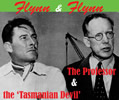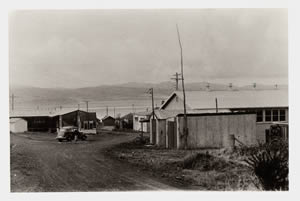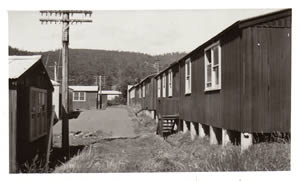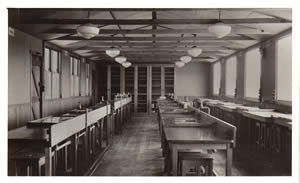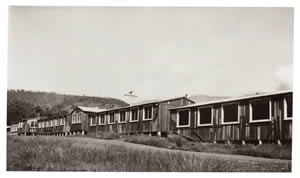|
Centenary of Biology at UTAS 1909 - 2009
2009 marks a historic year for the discipline of biology at the University of Tasmania. In April 1909, Theodore Thomson Flynn arrived in Tasmania to become the first lecturer in the newly established department in biology at the University of Tasmania. The University itself was then nineteen years old, having been established in June 1890.
Flynn was born in Coraki, New South Wales on 11 October 1883. Educated in Sydney, he received his BSc from the University of Sydney in 1909, and taught high school science before being appointed to the Newcastle and Maitland Technical Colleges as a lecturer in chemistry and physics. His appointment to the lectureship in Tasmania began what became an eminent career in biology.
Flynn’s wife Lily (later called Marelle) accompanied him to Tasmania, and their son Errol was born at the Queen Alexandra Hospital, Hobart, in 1909. Errol attended several schools in Hobart, and reportedly trapped bettongs for TT Flynn’s research into the reproductive biology of marsupials.
In 1910, the university received a substantial donation from the estate of John Ralston, a wealthy pastoralist from St Leonards, who left £8,000 to further scientific research. These funds, the first major bequest to the institution, were directed towards support of the new discipline of biology. The majority of the funds went to endow a chair, and the remainder were spent on a biology laboratory and the purchase of equipment. Flynn became the Ralston Professor of Biology and inaugural chair of the fledgling department in 1911.
Under the original terms of the agreement, Flynn was to carry out research into:
1. “diseases of plants and animals
2. anatomy and development of marsupials unique to Tasmania
3. any other research approved by the trustees”.
In 1921, a new agreement with the Ralston Trustees added a 4th category of approved research:
4. research on commercial food fisheries in Tasmania.
These themes are strongly echoed in current research strengths in the School of Zoology.
- The School is a leading player in current research into the Devil Facial Tumour Disease and the fight to save this iconic Tasmanian species
- Research into marsupial reproductive biology continues in the 21st century. Notably, Associate Professor Randy Rose (now retired) was inspired by Flynn’s pioneer work on bettongs to focus his own PhD on the reproduction of this Tasmanian marsupial.
- The School, through its current Chair, Professor Craig Johnson, is a core component of the Tasmanian Fisheries and Aquaculture Institute (TAFI), which carries out world-class research supporting the development and sustainable management of living marine resources.
The Ralston Trust continues to support excellence in Biology at UTAS through the annually awarded Ralston Trust Prizes for Zoology undergraduates.
In 2006, Fleet Street on the Hobart campus of the University of Tasmania was re-named T.T. Flynn Street in honour of our first Professor of Biology. (Notes by Professor Sue Jones - School of Zoology)
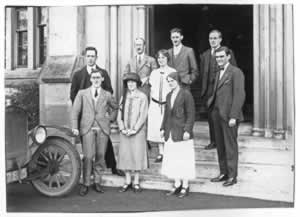
University staff and students with car
Group of staff and students at the University on the Domain c. 1924. Professor Flynn is in the back row on the far left. (Tasmaniana Library, Tasmanian Archive and Heritage Office) - enlarge |
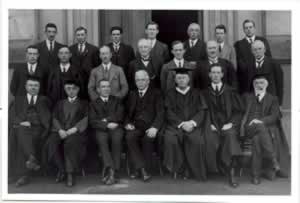
University staff group photo 1924
University staff, 1924; (l. to r., top) Dr. A.L. McAulay, H.P. Tuck, C. Malthus, Prof. J.B. Brigden, J.A. Johnson, Prof. Burn, Prof. D. Copland,; (centre) A.R. Hewer, P.L. Griffiths, Lt-Col. Thomas (Registrar), E.A. Counsel, C.C. Dudley, G.S. King, L. Rodway; (bottom) Prof. R. Dunbabin, Prof. Williams, W.J.T. Stops (Vice-Chancellor), Sir Elliott Lewis (Chancellor), Prof. McDougall, Prof. T.T. Flynn, Prof. Lucas - enlarge |
The history of the Biology Department
V.V. Hickman
Flynn was succeeded, initially as Ralston Lecturer, and, in 1943 as Professor, by his ex-student,Vernon Victor Hickman. Hickman was a noted invertebrate biologist with a deep interest in spiders, although he received his DSc in 1939 for his research into the primitive crustacean Anaspides. The School still holds many of Hickman’s specimens in its museum collection. (S. Jones)
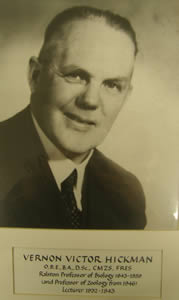 |
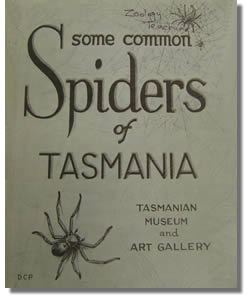 |
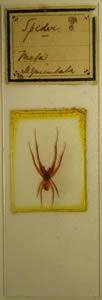 |
|
| V.V. Hickman |
Some Common Spiders of Tasmania by V.V.Hickman |
V. V. Hickman spider specimen microscope slide |
V.V. Hickman on Mount Wellington |
‘The History of the Biology Department can be divided into three clear geographical phases, the Domain Period, the Hut Period and the 'Room with a View' time'. [E.Guiler]
 |
Biology Department Staff at the Domain site, 1941
Miss Winifred M. Curtis, Dr. V.V. Hickman (Seated), Dr. H.D. Gordon. |
Biology moves to Sandy Bay
The first buildings at Sandy Bay, site of the present University, were temporary huts.
‘In April 1944 Biology, with fifteen second and third year students, was housed in a 40 by 30 foot hut. Lecturers had sometimes to teach in gumboots, such was the state of the surroundings.’
From:
Richard Davis, Open to Talent; the centenary history of the University of Tasmania 1890-1990, Hobart, University of Tasmania, 1990.
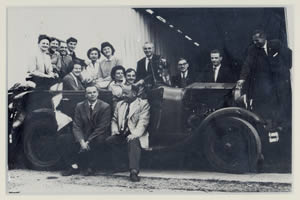 |
Biology staff 1960s at Sandy Bay site with Biology Department car which dates from the time of T.T.Flynn - Eric Guiler on right sitting on running board of the car. |
| |
|
The Hut Period
'The Hut period still is a vivid memory to those of us who were there. It was a most happy time. There was a camaraderie among the Hut People who were isolated from the Domain Dwellers of the Humanities and also isolated from Administration. Indeed, the Domain Dwellers tended to look down on the Hut People, biologists, physicists, geologists and geographers, as a rather peculiar and inferior race. The Hut People paid little attention to them and got on with their work which was to become an important, if not vital, basis for the reputation of the University.
Winifred Curtis found that despite the geographic isolation there was more socializing between the Domain and the Huts than when all were united on the Sandy Bay site.’
[notes by E. Guiler]
Eric Guiler
‘Eric Guiler had been a student of Flynn’s at Queens University Belfast and later followed him to the Zoology Department of the University of Tasmania. Guiler was also a distinguished researcher of Tasmanian marsupials and long-time chairman of the Animals and Birds Protection Board. He commented that TT Flynn ‘was an excellent scientist and a book he wrote on the embryology of marsupials is still the standard reference work throughout the world’.(Sunday Tasmanian 8 July 1990)
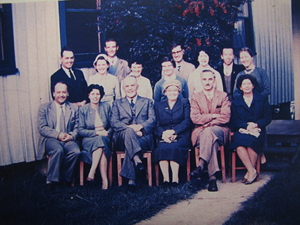 |
Left: Zoology Department afternoon tea 1961 to farewell V.V. Hickman on his retirement.
Back row left to right: John Hickman, Roma Hickman, John Grant (Lab. Assistant), Marg Carter (Secretary), Alison Green, Neil Brink, Julie Greenhill (Thompson), John Chooi, Ann Phillips (Button)
Front row left to right: Eric Guiler, Mrs. Clark, Emeritus Prof. Hickman, Mrs. Hickman, Prof. Clark, Mrs. Guiler
|
|
